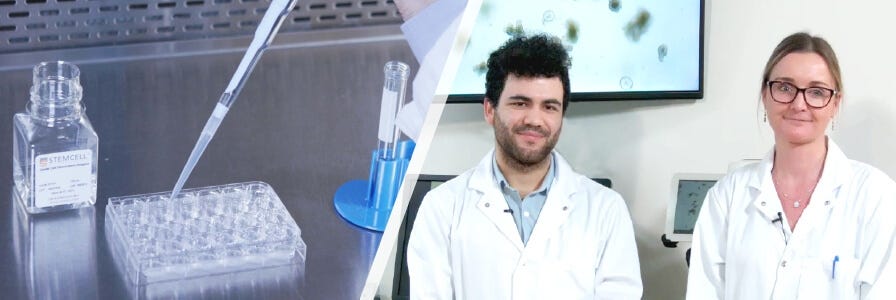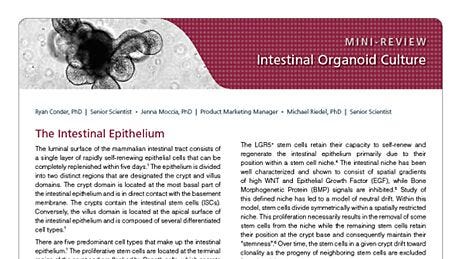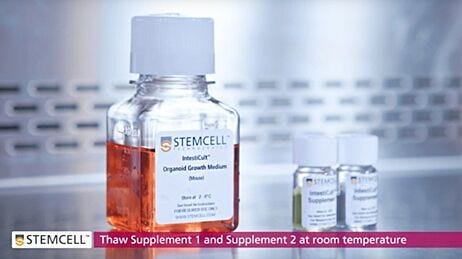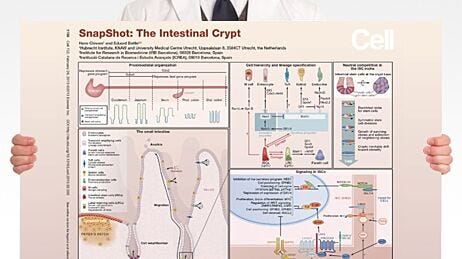Intestinal Organoid Classroom
Step-by-step laboratory procedural videos for culturing mouse intestinal organoids

Welcome to the Intestinal Organoid Classroom, where you will receive step-by-step instruction on how to grow mouse intestinal organoids alongside our organoid scientists. In preparation for the protocol, please review all of the course information and procedural videos to ensure that you have everything you need for training.
Intestinal Organoid Starter Kit & Additional Lab Materials
An Intestinal Organoid Starter Kit containing the following components is available for purchase:- Mouse Intestinal Organoids (Catalog #70931)
- IntestiCult™ Organoid Growth Medium (Mouse) (Catalog #06005)
- Gentle Cell Dissociation Reagent (Catalog #07174)
Store each component at the appropriate temperature as indicated on the labels. Please review and ensure you have obtained all of the additional materials required to set up the cultures as outlined in the Technical Bulletin: Intestinal Epithelial Organoid Culture with IntestiCult™ Organoid Growth Medium (Mouse).
Before You Begin
The training curriculum is designed to be reviewed sequentially. We encourage you to watch each procedural video prior to attempting that part of the protocol. Our Product and Scientific Support is available to support you through each stage of the protocol, please contact us at techsupport@stemcell.com.Image Submissions
We encourage you to submit photos of your intestinal organoid cultures over the span of the protocol. In order to evaluate the morphology and quality of the entire culture, please submit images using the lowest magnification available on your microscope. Please send your culture images to techsupport@stemcell.com.Lab Procedural Videos:
- Part 1: Thaw Cryopreserved Intestinal Organoids and Culture in IntestiCult™ Organoid Growth Medium (Mouse) (Starts at 25:10)
- Part 2: Observe Organoid Morphology in Culture at Day 0, Day 1, and Day 3. (Starts at 44:05)
Frequently Asked Questions
Is it possible to grow the organoids in 2D? If so, is there a specific media for differentiation or do the organoids differentiate in the maintenance media?
Yes, you can take 3D cultures into 2D cultures (Stappenbeck et al. paper); single cells are seeded onto coated transwell plates to differentiate.
Does the source of bovine serum albumin (BSA) matter for this protocol?
No, all BSA sources should suffice.
What is the optimal density for passaging? If there are too many organoids in a well, can it be passaged earlier before reaching maturity?
The optimal density is 100 organoids per well in a 50μl dome. If the well is too dense you can passage them early as subsequent passages will rescue the dome.
Do we need to add antibiotics to the medium?
Yes, you should add antibiotics because the organoids come from intestines and contain toxins.
Would the use of non-tissue culture (TC) treated plates be a better alternative than TC treated plates in order to prevent adherence to the bottom of the plate?
We recommend TC treated plates due to the spreading out and shape of the dome. With TC treated plates, the domes are more spread out. With non-TC treated plates, the domes are more compact and stand higher which can increase the risk of shearing the top of the dome when changing the medium.
Can IntestiCult™ Organoid Growth Medium (Mouse) be thawed in a 37°C water bath rather than at room temperature (15 - 25°C)?
Aliquots of IntestiCult™ Organoid Growth Medium can be thawed in a 37°C water bath before use, however, we do not recommend refreezing medium that has been thawed using this method.
What is the best indicator that an organoid culture was successful?
Morphology is the key determinant; you want a dark lumen with lots of buds. However, a darker lumen also means that more cells are dying and creating a toxic environment which can cause the buds to start deteriorating. Therefore, you’ll want to passage them before the lumen gets too dark.
What is the effect of cold or warm Gentle Cell Dissociation Reagent (GCDR) during the passaging protocol?
Cold GCDR will help further dissolve the Matrigel®, however it can also be used at room temp for our protocol because the mechanical pipetting up and down also dissolves the Matrigel®".
Can you add more or less media with domes of different densities?
It is recommended to use the same amount of media for all densities. High density domes of 70-100 organoids are optimal. With more organoids per dome, the rate of nutrient consumption is faster and the media turns yellow due to increased metabolism and therefore will need to be changed more frequently. If organoids are really sparse (20 per well), less nutrients are consumed and you can increase the time between media changes.
If a lot of debris and cell death is observed in the culture, could you passage the organoids early?
Passage organoids when they look mature, not based on level of debris. Mature = dark lumen and multiple buds. If you have lots of debris, consider doing an extra wash step when passaging.
Do different size fragments grow at different rates?
Bigger fragments grow better. Single cells or small fragments have much lower growth efficiency (10-15%) but will still grow.
How do you calculate the growth rate percentage?
Growth % = (Day 5 mature organoids counts)/ (Day 1 total counts)*100
Example: If you counted 20 fragments at Day 1, and 12 of these grew into *mature organoids by Day 5 then growth % = 12/20 = 60%
*Mature organoid = 2 or more buds
Is it okay to pre-warm the IntestiCult™ Organoid Growth Medium (Mouse) when feeding the domes?
Yes, and room temperature media is also okay.
Does the gender of the mouse matter for primary intestinal organoid isolation?
We used C57BL6, 8-week old males for standardization; however, females can be used if desired.
What can I do if I don’t have a rocking platform for the passaging incubation step?
Try and create a flow of liquid, you can use an orbital shaker or use your hand to rock. You want to avoid having the organoids settle to the bottom of the tube.
Can we mix multiple domes into one tube when passaging? How many?
Yes, you can scale up and make a relative calculation. There is no limit on how many domes to combine. Generally, we combine a maximum of 8 domes into one 15mL tube.
Have you tried passaging the organoids mechanically?
Yes, high throughput robotic systems work. Mechanical disruption without Gentle Cell Dissociation Reagent (GCDR) works but not as well. GCDR helps keep the fragments more consistent in size.
Why does the passaging protocol call for a 1:6 split ratio at P2 compared to a 1:1 split ratio at P1 (passage after post-thaw)?
One vial of organoids post-thaw (P0) can be split into 4 domes. This can be considered as the “recovery” phase and is not for expansion of the organoids. You would then passage these wells at a 1:1 split ratio; this is the growth phase (P1). The next passage is for expansion (P2) using a 1:4 or 1:6 split ratio. We suggest adding enough media/Matrigel® to prepare 6 domes to account for pipetting errors.
It is recommended to cryopreserve the organoids at day 6 when there are multiple buds per organoid. If necessary, can they also be cryopreserved 2-3 days after passaging?
Yes, there is a time range of being able to freeze the organoids down. Day 6 has maximum budding within each organoid (stem cells and Paneth cells are contained in the buds which will develop into new organoids). You can freeze down organoids at days 2-3 if there is a clear stem cell component, however, they may regrow with a lower efficiency.
Can organoids be cryopreserved as intact structures? If so, what would be the recommended size?
This is not recommended. Entire organoid structures will break down and fragments will die off during the thawing process and you will lose stem cell components.
Does the Matrigel® need to be a dome, or can it be flat and fill the entire well?
Organoids need to be seeded in a dome to prevent them from sinking to the bottom of the plate. If organoids make contact with the plastic they tend to differentiate and die. In addition, nutrients from the medium will find the center of the dome more readily versus a flat matrix.
Which small intestinal region is most efficiently cultured for organoids?
First 10 cm but the whole small intestine should work well.
What are the differences in growing human intestinal organoids? Do they need other growth factors?
Yes, human organoids are different and need different growth factors to inhibit various pathways and different levels of signaling.

STEMCELL Technologies
Dr. Ryan Conder is a Senior Scientist and Team Lead of the Intestinal Group in the Research and Development department. His group is responsible for developing products for 3D intestinal organoid culture, including IntestiCult™ Organoid Growth Medium (Mouse) and IntestiCult™ Organoid Growth Medium (Human). Prior to joining STEMCELL Technologies in 2012, Dr. Conder investigated the mechanisms regulating proliferation and differentiation of adult intestinal stem cells in the group of Dr. Juergen Knoblich at the Institute for Molecular Biotechnology of the Austrian Academy of Sciences. He is also a principle investigator on the Horizon 2020 European Research Council INTENS project.

STEMCELL Technologies
Fisal Elstone is a Senior Research Technologist within the Intestinal Group of the Research and Development department. Fisal's responsibilities are focused on the development of 3D culture medium and protocols within the intestinal research field. He also provides training to both customers and members of the Education & Product and Scientific Support team on intestinal organoid culture techniques. Fisal attended the University of British Columbia (UBC) in Canada, and received his BSc in the Integrated Sciences program. He was also enrolled in the Co-operative Education program where he gained exposure to both academic and industrial fields under the life sciences umbrella. Prior to joining STEMCELL Technologies, Fisal was an active member of UBC's Synthetic Biology Competition team under the International Genetically Engineered Machine (iGEM) Foundation; which held both regional, and international competitions annually.

STEMCELL Technologies
Dr. Jennifer Brockhausen is a Product and Scientific Support Specialist within the Education & Product and Scientific Support department. Jennifer has a PhD in Molecular Neuroscience from the University of Sydney in New South Wales. She completed her postdoctoral research at the Centenary Institute of Cancer Medicine and Cell Biology in Sydney, where she examined the regulation of microRNAs in liver disease models. In her current role, Jennifer specializes in STEMCELL Technologies’ Epithelial Media product portfolio and directly responds to customer inquiries to troubleshoot and provide technical support. She also serves as an instructor in training programs for internal staff, distributors, and customers.
Explore These Resources
Learn More
- Scientific Resource Tools for COVID-19 Research
- Scientific Resource Organoid Research
- Linkedin Organoid Cell Culture Group
- Webinar From Stem Cells to Organoids: Modeling the Gastrointestinal Tract
- Webinar Modeling Human Gastrointestinal Development and Disease Using Pluripotent Stem Cells
- Video Mouse Intestinal Organoid Passaging with IntestiCult™ Organoid Growth Medium
- Wallchart SnapShot: GI Tract Development
- Wallchart SnapShot: Growing Organoids from Stem Cells
- Scientific Poster Development of a 96-well Assay for Assessing Cell Viability in Mouse Small Intestinal-Derived Organoids after Treatment with Cytotoxic Compounds
- Scientific Poster Efficient Establishment and Long-Term Maintenance of 3-Dimensional Mouse Intestinal Organoids Using a Novel Defined and Serum-Free Medium




